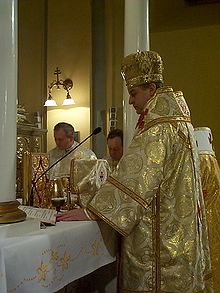


The sakkos (Greek: σάκκος, "sackcloth"[1]) is a vestment worn by Orthodox and Greek Catholic bishops instead of the priest's phelonion. The garment is a tunic with wide sleeves, and a distinctive pattern of trim. It reaches below the knees and is fastened up the sides with buttons or tied with ribbons. It is similar in form to the western dalmatic, which is similarly derived from Byzantine dress. The sakkos was originally worn by the Emperor as an imperial vestment, symbolizing the tunic of disgrace worn by Christ during his trial and mockery.
The sakkos is usually made of a rich brocade fabric and may be intricately embroidered. There is normally a cross in the center of the back, which the bishop kisses before it is placed on him. Buttons or loops are sewn on the back, by which the bishop's omophorion (either great or small) may be attached. Traditionally, bells are attached to the sakkos, following the biblical directions for the vestments of the Jewish High Priest (Exodus 28:33–34; 39:25–26).
- ^ Sokolof, Archpriest D. (1916), A Manual of the Orthodox Church's Divine Services, Jordanville, N.Y.: Printshop of St. Job of Pochaev (published 2001), p. 31